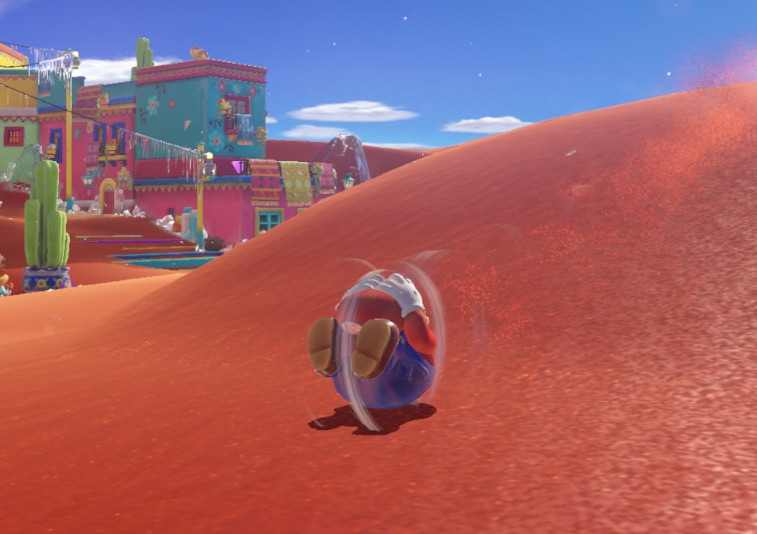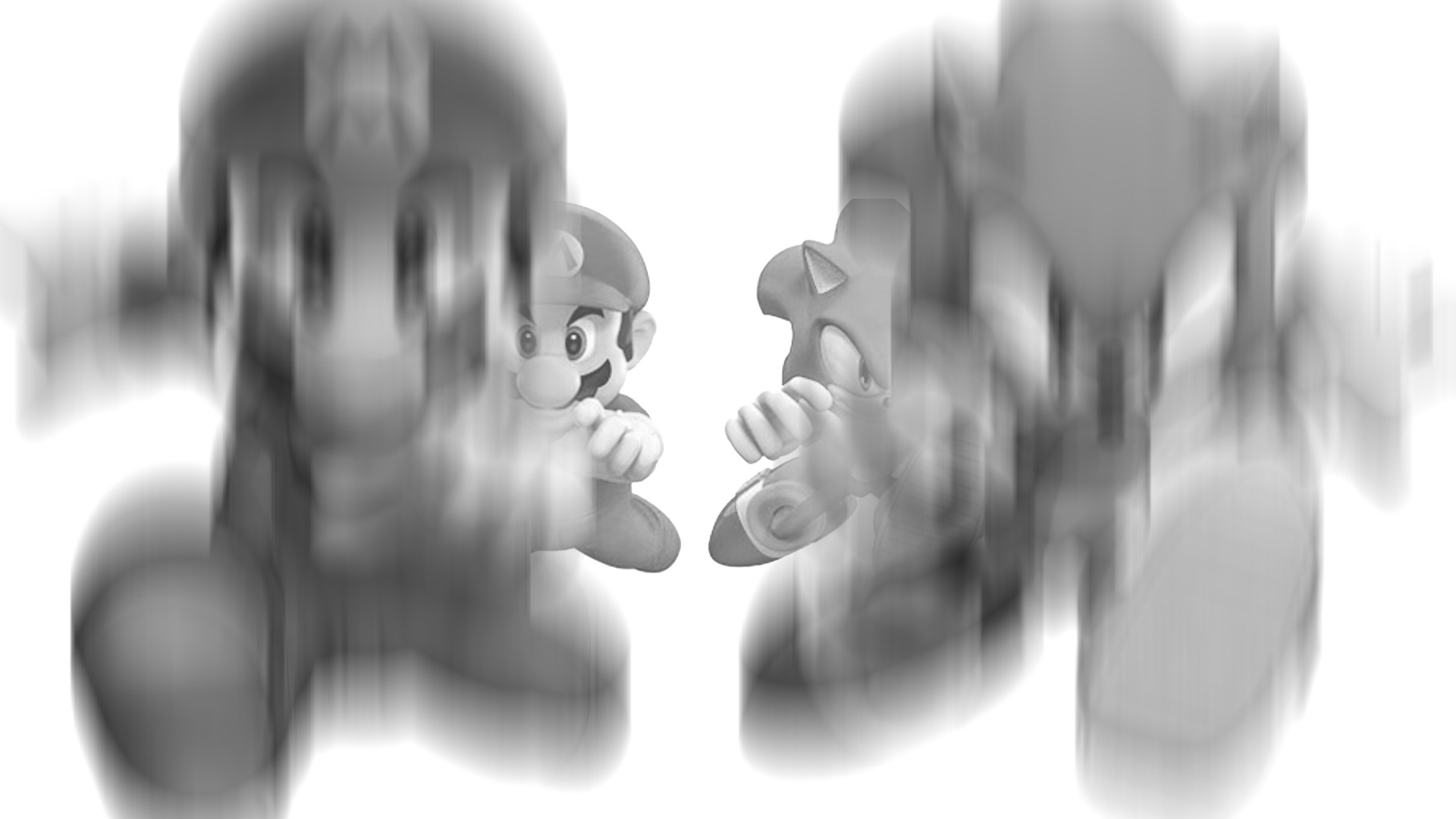Super Mario Odyssey is out and—surprise, surprise—it’s good. As expected, Mario’s as athletic as ever, with a myriad of moves and abilities that not only elevate his already impressive jumping skills but greatly extend his lateral movement options, as well. One of my personal favorites is Mario’s new ability that allows him to curl up into a ball and roll along the ground like some sort of armadillo or hedgehog or something. It’s like some sort of…spinning dash!

Wait a second…Great Gunpei’s Ghost! Super Mario Odyssey is the best 3D Sonic game ever!
Between the rolling technique and how Mario can preserve his speed through precise platforming, there are portions of Super Mario Odyssey that feel like the classic, momentum-based 2D Sonic gameplay in three dimensions. This is especially noticeable in timed segments such as the Koopa free-running missions where obtaining and maintaining Mario’s forward momentum by achieving fluidity of motion is essential. Much like classic Sonic, Super Mario Odyssey has a great sense of flow, which is something most 3D Mario titles can’t really boast.
There are portions of Super Mario Odyssey that feel like the classic, momentum-based 2D Sonic gameplay in three dimensions.
What is Momentum?
Okay, so before we can understand how Super Mario Odyssey achieves such an excellent sense of flow, we need to know what momentum is. In physics, momentum is the product of an object’s velocity and mass. In terms of video games, this means games that feature momentum-based mechanics have a few elements:
- The protagonist has mass.
- Mass implies the character has inertia.
- Inertia implies the character does not instantly accelerate and the character does not instantly decelerate. Moreover, the greater an object’s momentum, the more difficult it is to alter its course.
Some games that exhibit these traits:
- Asteroids: One of the earliest examples of momentum-based mechanics. The player’s ship does not accelerate instantly, but gradually, and continues to move even after the player has stopped using the ship’s thrusters. Moreover, altering the path of the ship requires substantial effort at high speeds.
- Super Mario Bros.: Mario accelerates quickly, but not instantaneously. He either jogs to a stop if he is running too fast or skids to a halt when trying to change direction.
- Sonic the Hedgehog: Sonic carries a lot of inertia. He accelerates slowly and must either skid to a halt or let his momentum slowly peter out.
Momentum as a Resource
In platformers like Mario and Sonic, the majority of the game’s challenge comes from executing precise acrobatics to navigate through the game’s various stages and their respective perils. Not only does the inclusion of momentum-based mechanics give the characters a satisfying sense of weight, but it adds an extra element of challenge. Because the character doesn’t move at top speed right away, building enough momentum to cross large gaps, find secrets, and ultimately complete the stage is an integral part of the game’s challenge.
So basically, in games that utilize momentum and inertia as mechanics, momentum is not only useful, but also—to some extent—scarce. This essentially makes it another kind of resource to be managed, much like health, ammo, or money. If you don’t mind the forced metaphor (all for the sake of a really cool, if not somewhat pretentious sounding, title), momentum is the currency of movement in Mario, Sonic, and similar games.
Essentially, momentum is another kind of resource to be managed.
Running with the fiscal metaphor, the value of this currency is different depending on the game: in Mario games, for instance, momentum is less critical in most situations than it is in Sonic games. That’s not to mention Sonic’s slightly slower acceleration and worse traction means manipulating his momentum takes more effort without the aid of outside forces or Sonic’s signature spin-dash—producing a greater scarcity of the desired momentum. This means that the plumber’s economy of motion has a higher saturation of momentum that has less demand than the hedgehog’s momentum, thus Mario’s momentum is generally less valuable by comparison.
Flow
With all of that out of the way, I can start unpacking what I meant by Mario Odyssey’s sense of flow. Flow—for the sake of this discussion, at least—means the smooth transition from one state of motion to another. Flow is important to games, even those that don’t heavily utilize momentum-based mechanics, though not in the way you’d think. People typically like flow, so when the player character takes damage, their flow is interrupted. This brief moment in which the player loses control and their character’s momentum suddenly shifts subconsciously communicates to the player that they’ve made a mistake.
Flow is the smooth transition from one state of motion to another.
This is why it’s typically not advisable to interrupt the game’s flow for something positive. Mario is a bit odd about this as many games do pause momentarily when the player snags a power-up, but the fact that the player’s momentum isn’t lost and instead continues a half second later may have something to do with why it’s not typically seen as an issue. But that’s really a minor nit-pick compared to the plumber’s more egregious violation of these principles: most notably the star-spin from Super Mario Galaxy and its sequel. Mario’s momentum completely stops as he lifts a short distance upward, leaving him with little ability to steer himself. This is awkward when combined with normal jumps, but it completely breaks any sort of flow when Mario is using a technique like the long jump. Mario goes from flying forward to barely having any lateral movement what-so-ever; it feels like running head-first into a wall, to be honest.

Super Mario Odyssey does away with this in two ways. First of all, Mario doesn’t lose much—if any—forward momentum when throwing Cappy. Secondly, Mario can immediately launch himself forward with his jumping dive maneuver. Between these two factors, it’s possible for a skilled player to utilize Cappy as jump-assistance without losing his forward momentum. As mentioned in this article’s introduction, this is used to great effect in the game’s timed missions and Koopa races, where Mario has to build up speed using the rolling maneuver and then hold onto to it through precise platforming and clever use of his aerial repertoire.
While Mario Odyssey is by no means a perfect game, the controls and Mario’s own acrobatic aptitude are spot on. In true Mario fashion, the mere act of moving is fun, especially when you get into a good rhythm and can bound across the game’s colorful locales uninterrupted. It’s also interesting to see Mario take a page from Sonic’s playbook and adopt a rolling maneuver that allows him to travel faster than he can on foot at the cost of control. Hopefully someone at Sega is paying attention, because that’s an idea worth stealing back!
P.S. In case you’re wondering, this is the actual greatest 3D Sonic game ever.
Glen
Latest posts by Glen (see all)
- Goodbye, Two Button Crew - 12/28/2023
- TBC 40: The Legend of Zelda: Tears of the Kingdom - 12/27/2023
- TBC 039: Super Mario 64 - 09/28/2023


